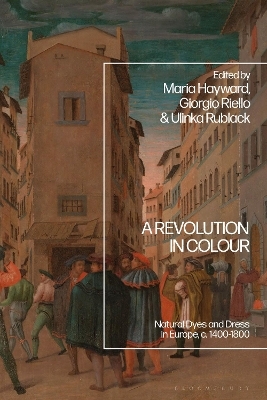
A Revolution in Colour
Bloomsbury Academic (Verlag)
978-1-350-40562-2 (ISBN)
Contributors shed new light on the economic, environmental, and cultural dimensions of colour in dress. The range of dyes expanded considerably in the sixteenth and seventeenth centuries, drawing on Asian and Mediterranean knowledge, new collections of recipes, and the greater diversity of plants available through New World trade. Working creatively with organic plant, animal, and mineral materials to make colours involved considerable knowledge, pleasure and skill. The creation of colour through dyes thus reveals a whole range of global agricultural and craft technologies that can inspire future material worlds and transforms our understanding of Europe´s cultural heritage.
Maria Hayward is a Professor in Early Modern History at the University of Southampton, UK. She is the author of Stuart Style: Monarchy, Dress and the Scottish Male Elite (2020), Rich Apparel: Clothing at the Law in Henry VIII’s England (2009) and Dress at the Court of King Henry VIII (2007). Giorgio Riello is Professor of Early Modern Global History at the European University Institute in Florence, Italy and Professor of Global History and Culture at the University of Warwick, UK. He is the co-editor (with Anne Gerritsen) of Writing Material Culture History (2014; 2nd Ed. 2021) Ulinka Rublack is Professor of Early Modern European History at Cambridge University, UK, and author of Dressing Up: Cultural Identity in Renaissance Europe (2010) and co-editor (with Giorgio Riello) of The Right to Dress: Sumptuary Legislation in a Global Perspective, c.1300-1800 (2018) and (with Maria Hayward) of The First Book of Fashion (2015).
List of Illustrations
Editors’ Introduction
1. The Arrival of the Crimson Dyeing Technique in Italy in the Late Fourteenth Century Luca Molà (University of Warwick, UK)
2. The Woad We Have Lost? The Changing Supply Networks of Tuscan dye Businesses between the Local and the Global, 1450-1650 Stephanie Lietzel (Harvard University, USA)
3. Crimson Dyes and the Law in Renaissance Italy Lisa Monnas and Jo Kirby (both Independent Scholars, UK)
4. The Limits of Global Trade: Cochineal and Indigo in the Pre-modern Period Giorgio Riello (European University Institute, Italy)
5. A Dyeing Art: Reconstructing Rosetti's Plictho Sophie Pitman (Aalto University, Finland)
6. The Colourful Language of Dyeing Black Sven Dupré (University of Utrecht, The Netherlands) and Natalia Ortegasaez (Antwerp, The Netherlands)
7. Re-Colouring Renaissance Dress: Matthäus Schwarz of Augsburg Ulinka Rublack (Cambridge University, UK)
8. Creating colour in the Stuart Royal Wardrobes, 1566-1701 Maria Hayward (University of Southampton, UK)
9. Innovations and Imitations of Fashion: Colour and Novelty in Early Modern Italian Dress Paula Hohti Erichsen (Aalto University, Finland)
10. French Indigo Trade from Marseille to Levant Marguerite Martin (IDHES - Université Paris I Panthéon Sorbonne, France)
11. Dyes and Dyeing in the Business of Indienne in the Eighteenth Century Kim Siebenhüner (Historisches Institut, Jena, Germany)
12. Identifying Different Pathways to Historical Colour for Scientific Analysis Anita Quye (University of Glasgow, UK)
Conclusion: The Cost of Colour: Colonial Networks and Embodied Histories Beverly Lemire (University of Alberta, Canada)
Index
| Erscheinungsdatum | 05.10.2024 |
|---|---|
| Zusatzinfo | 50 colour illus |
| Verlagsort | London |
| Sprache | englisch |
| Maße | 156 x 234 mm |
| Themenwelt | Kunst / Musik / Theater ► Design / Innenarchitektur / Mode |
| Kunst / Musik / Theater ► Kunstgeschichte / Kunststile | |
| Geisteswissenschaften ► Geschichte ► Regional- / Ländergeschichte | |
| Geschichte ► Teilgebiete der Geschichte ► Kulturgeschichte | |
| ISBN-10 | 1-350-40562-0 / 1350405620 |
| ISBN-13 | 978-1-350-40562-2 / 9781350405622 |
| Zustand | Neuware |
| Informationen gemäß Produktsicherheitsverordnung (GPSR) | |
| Haben Sie eine Frage zum Produkt? |
aus dem Bereich


